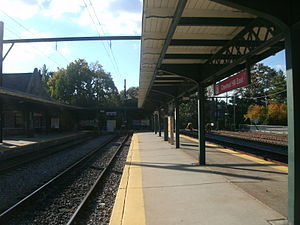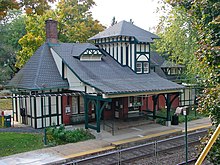railroad.wikisort.org - Train
The Chestnut Hill East Line is a route of the SEPTA Regional Rail (commuter rail) system. The route serves the northwestern section of Philadelphia with service to Germantown, Mount Airy, and Chestnut Hill. It is one of two lines that serve Chestnut Hill, the other one being the Chestnut Hill West Line. The line is fully grade-separated.
This article needs additional citations for verification. (August 2016) |
| Chestnut Hill East Line | |||||||||||||||||||||||||||||||||||||||||||||||||||||||||||||||||||||||||||||||||||||||||||||||||||||||||||||||||||||||||||||||||||||||||||||||||||||||||||||||||||||||||||||||||||||||||||||||||||||||||||||||||||||||||||||||||||||||||||||||||||||||||||||||
|---|---|---|---|---|---|---|---|---|---|---|---|---|---|---|---|---|---|---|---|---|---|---|---|---|---|---|---|---|---|---|---|---|---|---|---|---|---|---|---|---|---|---|---|---|---|---|---|---|---|---|---|---|---|---|---|---|---|---|---|---|---|---|---|---|---|---|---|---|---|---|---|---|---|---|---|---|---|---|---|---|---|---|---|---|---|---|---|---|---|---|---|---|---|---|---|---|---|---|---|---|---|---|---|---|---|---|---|---|---|---|---|---|---|---|---|---|---|---|---|---|---|---|---|---|---|---|---|---|---|---|---|---|---|---|---|---|---|---|---|---|---|---|---|---|---|---|---|---|---|---|---|---|---|---|---|---|---|---|---|---|---|---|---|---|---|---|---|---|---|---|---|---|---|---|---|---|---|---|---|---|---|---|---|---|---|---|---|---|---|---|---|---|---|---|---|---|---|---|---|---|---|---|---|---|---|---|---|---|---|---|---|---|---|---|---|---|---|---|---|---|---|---|---|---|---|---|---|---|---|---|---|---|---|---|---|---|---|---|---|---|---|---|---|---|---|---|---|---|---|---|---|---|---|---|---|
 The Chestnut Hill East station as seen in October 2012. The station depot, constructed by the Reading Company, is visible on the left. | |||||||||||||||||||||||||||||||||||||||||||||||||||||||||||||||||||||||||||||||||||||||||||||||||||||||||||||||||||||||||||||||||||||||||||||||||||||||||||||||||||||||||||||||||||||||||||||||||||||||||||||||||||||||||||||||||||||||||||||||||||||||||||||||
| Overview | |||||||||||||||||||||||||||||||||||||||||||||||||||||||||||||||||||||||||||||||||||||||||||||||||||||||||||||||||||||||||||||||||||||||||||||||||||||||||||||||||||||||||||||||||||||||||||||||||||||||||||||||||||||||||||||||||||||||||||||||||||||||||||||||
| Service type | SEPTA Regional Rail commuter service | ||||||||||||||||||||||||||||||||||||||||||||||||||||||||||||||||||||||||||||||||||||||||||||||||||||||||||||||||||||||||||||||||||||||||||||||||||||||||||||||||||||||||||||||||||||||||||||||||||||||||||||||||||||||||||||||||||||||||||||||||||||||||||||||
| Current operator(s) | SEPTA | ||||||||||||||||||||||||||||||||||||||||||||||||||||||||||||||||||||||||||||||||||||||||||||||||||||||||||||||||||||||||||||||||||||||||||||||||||||||||||||||||||||||||||||||||||||||||||||||||||||||||||||||||||||||||||||||||||||||||||||||||||||||||||||||
| Ridership | 3,874 (FY 2019 daily)[1] | ||||||||||||||||||||||||||||||||||||||||||||||||||||||||||||||||||||||||||||||||||||||||||||||||||||||||||||||||||||||||||||||||||||||||||||||||||||||||||||||||||||||||||||||||||||||||||||||||||||||||||||||||||||||||||||||||||||||||||||||||||||||||||||||
| Route | |||||||||||||||||||||||||||||||||||||||||||||||||||||||||||||||||||||||||||||||||||||||||||||||||||||||||||||||||||||||||||||||||||||||||||||||||||||||||||||||||||||||||||||||||||||||||||||||||||||||||||||||||||||||||||||||||||||||||||||||||||||||||||||||
| Termini | Chestnut Hill East 30th Street Station | ||||||||||||||||||||||||||||||||||||||||||||||||||||||||||||||||||||||||||||||||||||||||||||||||||||||||||||||||||||||||||||||||||||||||||||||||||||||||||||||||||||||||||||||||||||||||||||||||||||||||||||||||||||||||||||||||||||||||||||||||||||||||||||||
| Stops | 14 | ||||||||||||||||||||||||||||||||||||||||||||||||||||||||||||||||||||||||||||||||||||||||||||||||||||||||||||||||||||||||||||||||||||||||||||||||||||||||||||||||||||||||||||||||||||||||||||||||||||||||||||||||||||||||||||||||||||||||||||||||||||||||||||||
| Distance travelled | 18.1 mi (29.1 km) | ||||||||||||||||||||||||||||||||||||||||||||||||||||||||||||||||||||||||||||||||||||||||||||||||||||||||||||||||||||||||||||||||||||||||||||||||||||||||||||||||||||||||||||||||||||||||||||||||||||||||||||||||||||||||||||||||||||||||||||||||||||||||||||||
| Line(s) used |
| ||||||||||||||||||||||||||||||||||||||||||||||||||||||||||||||||||||||||||||||||||||||||||||||||||||||||||||||||||||||||||||||||||||||||||||||||||||||||||||||||||||||||||||||||||||||||||||||||||||||||||||||||||||||||||||||||||||||||||||||||||||||||||||||
| Technical | |||||||||||||||||||||||||||||||||||||||||||||||||||||||||||||||||||||||||||||||||||||||||||||||||||||||||||||||||||||||||||||||||||||||||||||||||||||||||||||||||||||||||||||||||||||||||||||||||||||||||||||||||||||||||||||||||||||||||||||||||||||||||||||||
| Rolling stock | Electric multiple units | ||||||||||||||||||||||||||||||||||||||||||||||||||||||||||||||||||||||||||||||||||||||||||||||||||||||||||||||||||||||||||||||||||||||||||||||||||||||||||||||||||||||||||||||||||||||||||||||||||||||||||||||||||||||||||||||||||||||||||||||||||||||||||||||
| |||||||||||||||||||||||||||||||||||||||||||||||||||||||||||||||||||||||||||||||||||||||||||||||||||||||||||||||||||||||||||||||||||||||||||||||||||||||||||||||||||||||||||||||||||||||||||||||||||||||||||||||||||||||||||||||||||||||||||||||||||||||||||||||
History

The Chestnut Hill East Line is a continuation of the Reading Company's suburban services on the Chestnut Hill East Branch from Philadelphia to Germantown and Chestnut Hill. The oldest part of the line that became the Chestnut Hill East Branch was opened in 1832 by the Philadelphia, Germantown and Norristown Railroad, and later became part of the Reading system. Electrified service began on February 5, 1933.[2]
Until 1984 Chestnut Hill East trains used the Reading Viaduct to reach Spring Garden Street and the Reading Terminal; this ended with the opening of the Center City Commuter Connection which routed the trains through the city center and on the ex-Pennsylvania Railroad part of the system.[3] From this point the route was designated R7 Chestnut Hill East as part of SEPTA's diametrical reorganization of its lines; trains continued on to the Trenton Line.[4] The R-number naming system was dropped on July 25, 2010.[5] As of 2022[update], most Chestnut Hill East Line trains continue through Center City to the Trenton Line.[6]
SEPTA activated positive train control on the Chestnut Hill East Line on July 25, 2016.[7]
On April 9, 2020, service on the line was suspended due to the COVID-19 pandemic,[8] though Temple University and Wayne Junction stations were still being served by other rail services. Service resumed on June 28, 2020.[9]
Stations


The Chestnut Hill East line makes the following station stops after leaving the Center City Commuter Connection; stations indicated with a gray background are closed. All stations are located within the city of Philadelphia.[10]
| Zone | Location | Station | Miles (km) from Center City |
Connections / notes |
|---|---|---|---|---|
| C | Temple University | Temple University |
2.1 (3.4) | |
| Nicetown–Tioga | ||||
| Tioga | Closed 1989 | |||
| Nicetown | Closed November 14, 1988 due to fire damage[11] | |||
| 1 | Wayne Junction |
5.1 (8.2) | ||
| Wister | ||||
| Fishers | 5.7 (9.2) | Closed October 4, 1992[12] | ||
| Wister | 6.1 (9.8) | |||
| East Germantown | ||||
| Wingohocking | 6.5 (10.5) | |||
| Germantown | 6.8 (10.9) | |||
| 2 | Walnut Lane | 7.7 (12.4) | ||
| Washington Lane | 7.8 (12.6) | |||
| East Mount Airy | Stenton | 8.6 (13.8) | ||
| Gorgas | 8.7 (14.0) | |||
| Sedgwick | 8.9 (14.3) | |||
| Mount Airy | 9.3 (15.0) | |||
| Chestnut Hill | ||||
| Mermaid | 9.8 (15.8) | |||
| Wyndmoor | 10.0 (16.1) | |||
| Gravers | 10.3 (16.6) | |||
| Chestnut Hill East | 10.8 (17.4) |
Ridership
Yearly ridership on the Chestnut Hill East Line between FY 2008–FY 2019 has remained steady around 1.4–1.6 million, save for a dip in FY 2019.[note 1]
Notes
References
- "Fiscal Year 2021 Service Plan Update". SEPTA. June 2020. p. 24. Retrieved March 11, 2022.
- Coates, Wes (1990). Electric trains to Reading Terminal. Flanders, NJ: Railroad Avenue Enterprises. pp. 74–75. OCLC 24431024.
- Williams, Gerry (1998). Trains, Trolleys & Transit: A Guide to Philadelphia Area Rail Transit. Piscataway, New Jersey: Railpace Company. p. 49. ISBN 978-0-9621541-7-1.
- Vuchic, Vukan; Kikuchi, Shinya (1984). General Operations Plan for the SEPTA Regional High Speed System. Philadelphia: SEPTA. pp. 2–8.
- Lustig, David (November 2010). "SEPTA makeover". Trains Magazine. Kalmbach Publishing: 26.
- "Chestnut Hill East Line schedule" (PDF). SEPTA. December 16, 2018. Retrieved December 24, 2018.
- "Positive Train Control Update". SEPTA. May 1, 2017. Retrieved May 17, 2017.
- "Service Information". SEPTA. Retrieved April 14, 2020.
- "SEPTA Regional Rail & Rail Transit Lifeline Service" (PDF). SEPTA. 2020. Retrieved April 14, 2020.
- "Chestnut Hill East Line Timetable" (PDF). Philadelphia, Pennsylvania: Southeastern Pennsylvania Transportation Authority. September 10, 2017. Retrieved November 3, 2017.
- Bowden, Mark (December 23, 1988). "A SEPTA Ride to a Sealed Station". The Philadelphia Inquirer. p. 15. Retrieved October 19, 2017 – via Newspapers.com.

- Dougherty, Frank (October 25, 1996). "Septa Board Cuts Service But Opposition Is Spirited". The Philadelphia Inquirer. Retrieved November 3, 2017.
- "Fiscal Year 2020 Annual Service Plan" (PDF). SEPTA. June 2019. p. 42. Retrieved December 14, 2019.
- "Fiscal Year 2019 Annual Service Plan" (PDF). SEPTA. June 2018. p. 74. Retrieved December 14, 2019.
- "Fiscal Year 2018 Annual Service Plan" (PDF). SEPTA. June 2017. p. 44. Retrieved December 14, 2019.
- "Fiscal Year 2017 Annual Service Plan" (PDF). SEPTA. October 2016. p. 70. Retrieved December 14, 2019.
- "Fiscal Year 2016 Annual Service Plan" (PDF). SEPTA. June 2015. p. 94. Retrieved December 14, 2019.
- "Fiscal Year 2015 Annual Service Plan" (PDF). SEPTA. May 2014. p. 60. Retrieved December 14, 2019.
- "Fiscal Year 2014 Annual Service Plan" (PDF). SEPTA. May 2013. p. 44. Retrieved December 14, 2019.
- "Fiscal Year 2013 Annual Service Plan" (PDF). SEPTA. May 2012. p. 55. Retrieved December 14, 2019.
- "Fiscal Year 2012 Annual Service Plan" (PDF). SEPTA. July 2011. p. 94. Retrieved December 14, 2019.
- "Fiscal Year 2011 Annual Service Plan" (PDF). SEPTA. June 2010. p. 70. Retrieved December 14, 2019.
- "Fiscal Year 2010 Annual Service Plan" (PDF). SEPTA. June 2009. p. 63. Retrieved December 14, 2019.
External links
Другой контент может иметь иную лицензию. Перед использованием материалов сайта WikiSort.org внимательно изучите правила лицензирования конкретных элементов наполнения сайта.
WikiSort.org - проект по пересортировке и дополнению контента Википедии